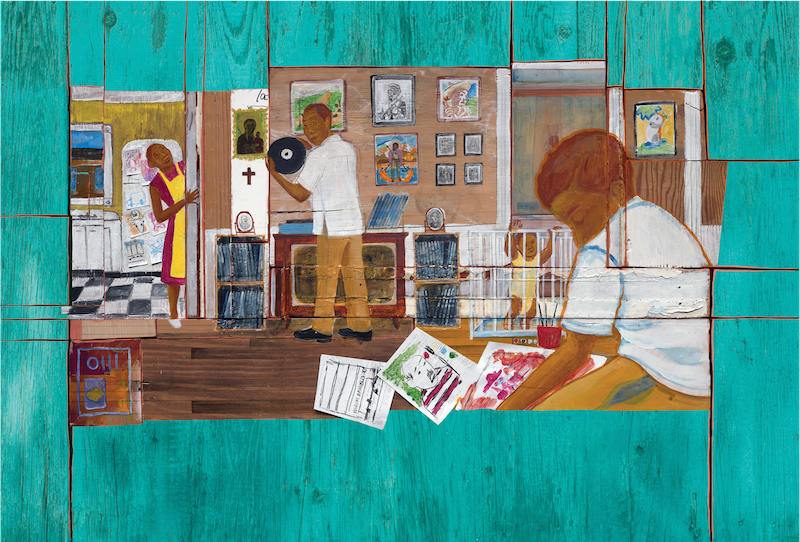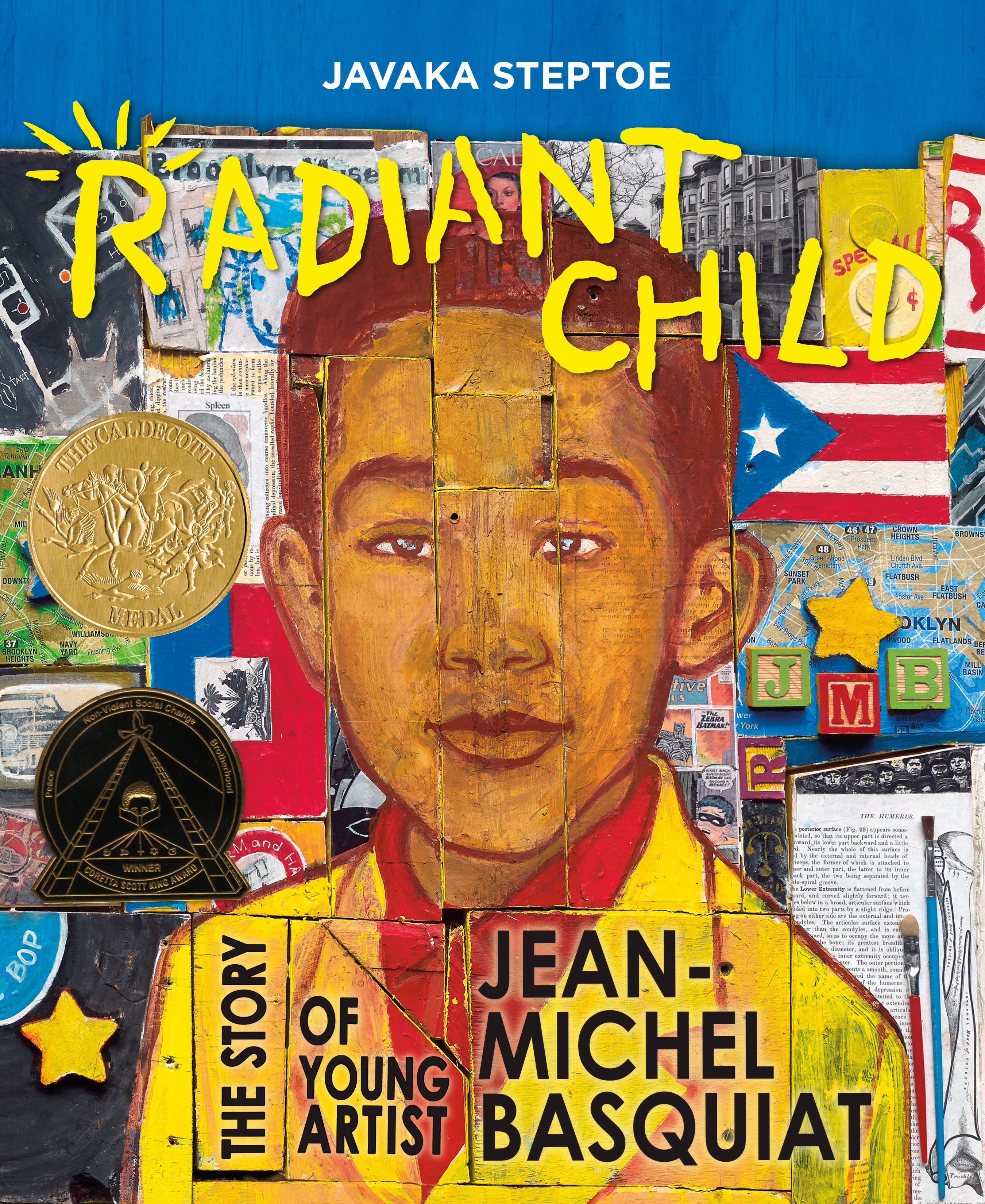An Interview with Javaka Steptoe, 2017 Caldecott Medal Winner
June 16, 2017
Hidden%20Chapel%20Studios_2.JPG)
Javaka Steptoe is an award-winning children's book author and illustrator. His recent book Radiant Child: The Story of Young Artist Jean-Michel Basquiat has been awarded the Caldecott Medal. He will speak at Skokie Public Library on Monday, June 26 from 2 - 3 pm. Everyone is welcome to attend this event. Register here. Books will be available for signing courtesy of The Book Stall.
Like Jean-Michel Basquiat, Javaka comes from an artistic family in New York City. His parents were both artists and his father, John Steptoe, was also an author and illustrator of children's books. John Steptoe received two Caldecott Honors, one for his 1985 book The Story of Jumping Mouse: A Native American Legend and again in 1988 for Mufaro's Beautiful Daughters: An African Tale. The Caldecott Medal is awarded annually in recognition of the most distinguished American picture book for children
We are pleased that Javaka recently took the time to talk to us about Basquiat’s art, his own work with collage, the importance of diversity in books, and the impact libraries have had on his own life.
What drew you to Basquiat, was it his artistic style, his life, his experiences?
All of the above. His style was exciting, it took elements of popular culture, New York City culture—culture that I was familiar with—comic book characters, games, things that people did or experienced in the culture of New York, if not the wider culture of America. The excitement and the freeness of his artwork and also the intelligence of it. A lot of people like to describe the energy in his artwork and the freeness, but people don't always talk about the intelligence. Even though part of his artwork was about randomness—what was in the area at the time—there's still a thought process that comes to; how are these things being chosen and how are these elements from the environment being chosen and then, how are they being put together in the artwork to create a statement? All of those different things, and in addition to that, just the fact that, when you hear about Basquiat a lot of time from art critics or the established keepers of the gate, he's talked about with loathing. He's always talked about as a graffiti artist. He's always talked about as someone who was homeless, or from a less than reputable place, and it's not true. He's also someone who a lot of artists of color—they see his work, they see his accomplishments, and they're drawn to him because they're familiar with what he's talking about, they're familiar with the things that he's representing, the colors that he's using. They're familiar with his anger, they're familiar with his joys. He was an artist chosen by the people across cultural, racial lines.
 An example of Javaka's artwork from Radiant Child
An example of Javaka's artwork from Radiant Child
You've talked before about the importance of collage to African-American art and experience, is that what drew you to collage?
I like collage because, for me it adds another layer of excitement and challenge. It also allows people to see beauty in everyday objects and everyday things. I'm a person who likes to stay engaged and I like for things to be interesting. I'm interested in exploring materials. I'm interested in seeing if I could eke out deeper meaning. I'm interested in my materials contributing to the telling of the story. I'm interested in there being nuance in the work, where you can come back to it, you can find something different and new and see something in it in a new way. So all of those different things draw me to collage.
"In terms of the history, there's a history of slavery in America, a history of oppression in America. It means that you weren't necessarily privy to the specialized tools, so you had to take what you had."
There's also the part about, just my parents being artists and my mother being a very phenomenal collage artist and growing up watching her work and then also my father doing the same thing, even though he's not thought of as someone who used collage. In terms of creating the book about Basquiat, that level of collage absolutely fit into his work, because of him painting on doors and windows and refrigerators and stuff like that.
In terms of the history, there's a history of slavery in America, a history of oppression in America. It means that you weren't necessarily privy to the specialized tools, so you had to take what you had. You were given the sheets or the drapes and you needed clothes, so they weren't sheets or drapes anymore. They became a shirt, they became a dress, and then the scraps from the dress became a blanket. I think that's important, not only in the context of oppression, but just in the context of life. That's how traditionally people lived because life was hard and if you were a hunter, you didn't just eat the meat and throw everything else away, you needed boots so you kept the leather. It's also a green statement. We don't have to keep consuming. We can use what's here. The paper's wrinkled? We can still use it. You don't need a whole new paper.

When you sourced the materials you painted on to make the collages, did you go the neighborhoods where Basquiat hung out?
Definitely. I found stuff just walking around Brooklyn. I specifically went to the Brooklyn Museum and I got wood from their Dumpster. I specifically went to Soho and I found wooden boxes and crates and things like that on the street so I gathered some stuff from there. Also, taking photos of places, because part of the fun of this book for me is that I lived during the time that Basquiat was around. He's older than me, but I ran through the Village and hung out and went to parties and bars and things like that, so there's a knowingness that I have, not just based in academics of the books that I read or the interviews and things like that, I know at certain points what clubs were hot and where people were congregating and things like that. In addition to taking a photograph of where Annina Nosei’s gallery used to be, which is now a woman's clothing store, I took pictures of places that I knew people were hanging out and gathering.
How long did that whole process take from when you started until when you were finished with it?
It took the entire time. (Laughs) It took about five years, six years, maybe. The reason why I say it took the entire time is because, there's always new information popping up and until the artwork is in the hands of the book company, I could always add something to it.
Your father was a Caldecott winner, both your parents were artists and you were working alongside of them when you were a kid making art, so are children’s books a natural fit for you—what in particular draws you to them?
Definitely the influence of my parents. My father just explaining to me the importance of there being diverse books and the idea of windows, mirrors, and sliding glass doors, and how diversity is beneficial for all of us. It broadens your perspective of the world and it makes you more intelligent and I think I was just raised as an artist: you create a project and it's about whatever you're interested in. It's about whatever you're passionate about and children’s books allow that, especially if you're a writer and an illustrator. If you're just the illustrator, then you'd have to be a very successful one to have the choice of saying no, I'm not really interested in this project, but as someone who writes and illustrates, you get to self select and you get to talk about what you're passionate about. My training is in fine arts and that's really what fine artists do, they say, I'm interested, I'm passionate in this or that, and they explore it.
"(The library) was a gathering place, a community place, a place where we were able to come together and have fun and express ourselves and read some really cool books."
What role did libraries play in your development as an artist or as a person?
I would say a big influence. I was a library kid. I definitely loved playing outside, roughhousing, and stuff like that, but I also had a relationship with the library. I would say the libraries I was a part of were more like today's library where it wasn't like the lady librarian with the bun and the glasses telling everyone to shh. It was a gathering place, a community place, a place where we were able to come together and have fun and express ourselves and read some really cool books.
I really enjoyed reading as a kid, so I would read a lot of fantasy and sci-fi books. I really loved biographies and comic books and the fact that I read helped me to develop stories, and the fact that I drew helped me to be interested in creating stories because I would create characters being inspired by the books that I read, being inspired by the comic books that I read. The library, whether it's a school library, whether it's a house library, whether it's a public library, was very supportive, was very helpful in that process.
What is the most positive thing that has come out of the recognition that you and Radiant Child have received?
I feel like it's yet to be seen. Definitely, I get more money, I get more school visits, people tell me that they're looking at Basquiat in a different way now. I know I have a bigger platform now and I know that means something in this society. In a world of 'likes' now I have more 'likes'. Those 'likes' can be transformed into anything I want to talk about.